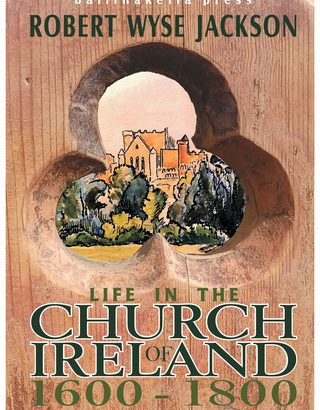Life in the Church of Ireland 1600-1800
by Robert Wyse Jackson (Ballinakella Press, €17.50)
Robert Marshall
Published initially in 1941 under the title Scenes from Irish Clerical Life in the 17th and 18th Centuries, this book was written by a clergyman of the Church of Ireland who had read law at Trinity College Dublin and been called to the English bar at the Middle Temple, London before being ordained in 1934.
Wyse Jackson raises many questions about the role and practice of religion in a society long gone. His book will be of special interest to many readers outside the Church of Ireland as giving an inner view of what was, by and large, an era of change.
Following his return to Ireland, he was elected a member of the Royal Irish Academy (1942). Appointed Dean of Cashel (1946), he was consecrated for the Bishopric of Limerick, Ardfert and Aghadoe in 1961, where he served until 1970.
The author seeks to recover the identity of the people who made up the Church of Ireland in the 200 years before the Act of Union. It is not a systematic history of the Church and avoids the complications of political life.
Approach
Wyse Jackson sets out his approach to history in the opening lines: “The truest history is that which gives a genuine picture of the man in the street, his hopes and fears, likes and dislikes, his amusements and his spiritual life.”
So inevitably a wide variety of people cross Wyse Jackson’s stage. The notorious Miler McGrath, Archbishop of Cashel for 36 years until 1604, and whose family held the best part of 100 benefices, must be contrasted with the diligent Philip Skelton (1707- 1787), incumbent of Pettigo who during the famine of 1756 went from cabin to cabin; tried and rejected the diet of boiled weeds, and, to cope with the demand, sold his library to buy oats.
There were, too, devout and generous bishops, such as Berkeley in Cloyne, Marsh in Dublin, Foy in Waterford, and Boulter the Primate in Armagh, who all make their appearance.
Wyse Jackson notes how every 30 years during the 17th Century achievements were broken down and rebuilding had to begin again.
Rebuilding was the task of Jeremy Taylor in Down and Connor. After the Cromwellian Interregnum Taylor dismissed 29 of his clergy who refused to conform to the new order of the Restoration. William King imprisoned in Dublin Castle in 1689, subsequently worked as bishop of Derry to revive a badly damaged church system. While archbishop of Dublin, King complained that the diocese of Ferns was served by only 13 beneficed clergy and nine £30 curates.
Subsequently, the peregrinations of John Wesley in the mid-18th Century further disrupted the Church of Ireland: the fruitful Methodist legacy of those journeys remains to this day.
Scripture
Wyse Jackson draws on the writings of Jeremy Taylor and Jonathan Swift as he examines the art of preaching. Taylor’s advice was to avoid busy arguing about the hard places of Scripture, and to be positive rather than negative in preaching: above all not to draw men from the wisdom of God to the follies of men.
Swift’s advice is for simplicity (without which no human performance can arrive at perfection). Just tell people what is their duty, and then convince them to do it.
Some scenes are described from the letters of Mrs Delany, a clerical wife: one scene her account of the hospitality of the bishop of Killala on the occasion of his wife’s birthday, including a visit to the bare-back horse racing on the strand.
Undoubtedly the dignitaries enjoyed great privilege, but to the extent that the sources permit, the lowly parson and the curate, the parish clerk and the church wardens make their appearance.
Though the parish clerk of that day (who gave the lead to the congregation at services) has gone. But the churchwarden still exists. The churchwardens did not hold a sinecure.
Elected annually their duties were on the interface between the established church as an instrument of local government and the people.
Their duties were not just the provision of stocks for those who disturbed worship, but the collection of the charges made on parishioners to pay for watchmen and the lighting of urban streets.
In 1941 this book was in advance of its time, for then history was more focused on institutions rather than on persons; nowadays history seeks to understand the daily lives of men and women.
Robert Marshall is a non-stipendiary minister of the Church of Ireland.



